

Automation Will Change the World Sooner Than You Think. The Lights in the Tunnel” by Martin Ford explores the implications of the increasing automation of labor.
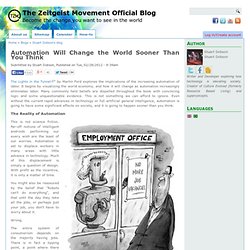
It begins by visualizing the world economy, and how it will change as automation increasingly eliminates labor. Many commonly held beliefs are dispelled throughout the book with convincing logic and some unquestionable evidence. This is not something we can afford to ignore. LIGHTSTUNNEL.PDF (Objet application/pdf) The Lights In the Tunnel - Automation, Accelerating Technology and the Economy of the Future. Human-Computer Interaction Institute. The Evolution of Symbiosis - The Evolution of Symbiosis.pdf. The Proactive Web Era : Intelligent Web and Intelligent Services are knocking at the door ! Translated from the french original article :

Intelligent agent. Simple reflex agent Intelligent agents are often described schematically as an abstract functional system similar to a computer program.
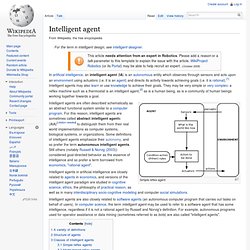
For this reason, intelligent agents are sometimes called abstract intelligent agents (AIA)[citation needed] to distinguish them from their real world implementations as computer systems, biological systems, or organizations. Human Workers, Managed by an Algorithm. Global workforce: Remote digital workers earned $0.32 each for producing these self-portraits.
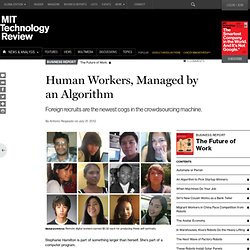
Stephanie Hamilton is part of something larger than herself. She’s part of a computer program. The 38-year-old resident of Kingston, Jamaica, recently began performing small tasks assigned to her by an algorithm running on a computer in Berkeley, California. That software, developed by a startup called MobileWorks, represents the latest trend in crowdsourcing: organizing foreign workers on a mass scale to do routine jobs that computers aren’t yet good at, like checking spreadsheets or reading receipts. RoboEarth. Autonomous Agents and Multi-Agent Systems (AAMAS) SymbioticSphere toward an autonomic grid network system. The RoboEarth Cloud Engine. Stigmergy. Forget Dunbar’s Number, Our Future Is in Scoble’s Number. Bottlenose. Category:Cellular automata. Internet Traffic is now 51% Non-Human. Bio-inspired computing. Bio-inspired computing, short for biologically inspired computing, is a field of study that loosely knits together subfields related to the topics of connectionism, social behaviour and emergence.
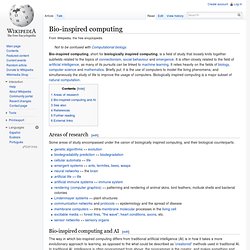
It is often closely related to the field of artificial intelligence, as many of its pursuits can be linked to machine learning. It relies heavily on the fields of biology, computer science and mathematics. Briefly put, it is the use of computers to model the living phenomena, and simultaneously the study of life to improve the usage of computers. Report: 51% of web site traffic is 'non-human' and mostly malicious. Incapsula, a provider of cloud-based security for web sites, released a study today showing that 51% of web site traffic is automated software programs, and the majority is potentially damaging, -- automated exploits from hackers, spies, scrapers, and spammers.

The company says that typically, only 49% of a web site's visitors are actual humans and that the non-human traffic is mostly invisible because it is not shown by analytics software. This means that web sites are carrying a large hidden cost burden in terms of bandwidth, increased risk of business disruption, and worse. Report: Bot traffic is up to 61.5% of all website traffic. Last March we published a study that showed the majority of website traffic (51%) was generated by non-human entities, 60% of which were clearly malicious.

As we soon learned, these facts came as a surprise to many Internet users, for whom they served as a rare glimpse of “in between the lines” of Google Analytics. Since then we were approached with numerous requests for an updated report. Cellular automaton. The concept was originally discovered in the 1940s by Stanislaw Ulam and John von Neumann while they were contemporaries at Los Alamos National Laboratory.
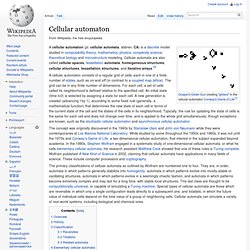
While studied by some throughout the 1950s and 1960s, it was not until the 1970s and Conway's Game of Life, a two-dimensional cellular automaton, that interest in the subject expanded beyond academia. In the 1980s, Stephen Wolfram engaged in a systematic study of one-dimensional cellular automata, or what he calls elementary cellular automata; his research assistant Matthew Cook showed that one of these rules is Turing-complete. Wolfram published A New Kind of Science in 2002, claiming that cellular automata have applications in many fields of science. These include computer processors and cryptography. Adapting to a Highly Automated World.
Multi-agent system. Simple reflex agent Learning agent Concept[edit] Multi-agent systems consist of agents and their environment.

Typically multi-agent systems research refers to software agents. The Rise of the Personal Intelligent Search Agent. If Your Shrink Is A Bot, How Do You Respond? : Shots - Health News. Ellie (right) is a computer simulation designed to engage real people, like the woman on the left, in meaningful conversation and take their measure.

Web 4.0: The Ultra-Intelligent Electronic Agent is Coming. Without getting too far ahead of ourselves, it is useful to look back at the various iterations of the Internet to see how it has evolved and where we might reasonably expect to see it go in the coming years and decades. The defining aspect of Web 1.0 was search. In other words, think Yahoo! In the early 1990s. Category:Multi-agent systems. Shyam Sankar : L'avènement de la coopération homme-machine. Complexity and Ecosystem Management: The Theory and Practice of Multi-Agent Systems. Quand l’homme sert de machine à la machine. Par Rémi Sussan le 17/11/10 | 4 commentaires | 2,798 lectures | Impression Tout le monde est d’accord pour dire que “l’infobésité” sera probablement l’un des gros problèmes du siècle qui commence.
Et ce qui est déjà difficile pour tout un chacun devient une question vitale pour certaines catégories professionnelles, comme les militaires, les agents de renseignements et autres pratiquants d’activités à risque. On sait que l’intelligence artificielle est pour l’instant bien loin de pouvoir les aider. En revanche, on peut espérer compter sur des techniques d’hybridation homme-machine. C’est en partant de ce postulat que Paul Sajda, directeur du Laboratoire d’imagerie intelligente et de neuroinformatique de l’université de Columbia, a développé un système permettant de repérer rapidement dans une masse de photographies celles qui correspondent à certains critères prédéfinis. La technique est assez simple.
Image : photogramme du film disponible sur IEEE.tv. Via Next Big Future. Artificial Intelligence, Powered by Many Humans. Personal assistants such as Apple’s Siri may be useful, but they are still far from matching the smarts and conversational skills of a real person. Researchers at the University of Rochester have demonstrated a new, potentially better approach that creates a smart artificial chat partner from fleeting contributions from many crowdsourced workers. Crowdsourcing typically involves posting simple tasks to a website such as Amazon Mechanical Turk, where Web users complete them for a reward of a few cents. The tasks are often simple, repetitive jobs that are easy for humans but tough for computers, such as categorizing images. Crowdsourcing has become a popular way for companies to handle such tasks, but some researchers, including the group at Rochester, believe it can also be used to take on more complex tasks.
In trials of the system, people asked Chorus for advice on restaurants to visit in Los Angeles and New York, and quickly received suggestions. Environmental Modelling & Software - Putting humans in the loop: Social computing for Water Resources Management. Abstract The advent of online services, social networks, crowdsourcing, and serious Web games has promoted the emergence of a novel computation paradigm, where complex tasks are solved by exploiting the capacity of human beings and computer platforms in an integrated way.
Water Resources Management systems can take advantage of human and social computation in several ways: collecting and validating data, complementing the analytic knowledge embodied in models with tacit knowledge from individuals and communities, using human sensors to monitor the variation of conditions at a fine grain and in real time, activating human networks to perform search tasks or actuate management actions. This exploratory paper overviews different forms of human and social computation and analyzes how they can be exploited to enhance the effectiveness of ICT-based Water Resources Management. Keywords. Interactive evolutionary computation. Art by Evolution on the Web. Can Creativity be Automated? NetLogo. NetLogo is an agent-based programming language and integrated modeling environment. Gridcosm. Drawball.com.
Gridcosmviewer.swf (Objet application/x-shockwave-flash) SHAPE THE HIVE - An Experiment In Interactive Collaboration. Agent-based model. Organic computing. The vision of Organic Computing and its fundamental concepts arose independently in different research areas like Neuroscience, Molecular Biology and Computer Engineering. Monitoring and Surveillance Agents.
Adding Human Intelligence to Software. Human Computation. Human-based computation. Human-based genetic algorithm.